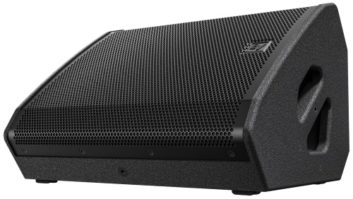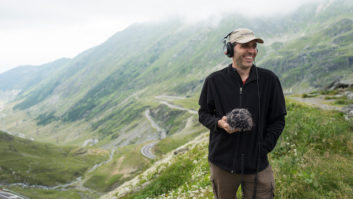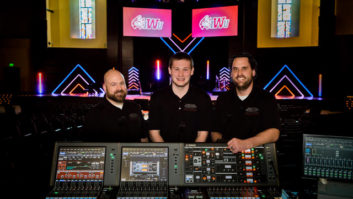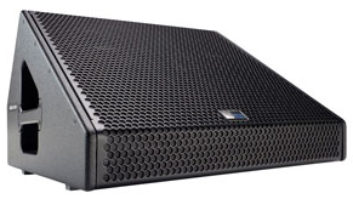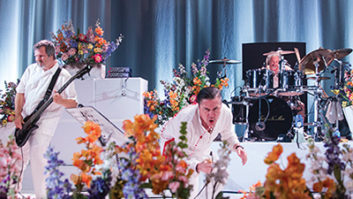
The lights go down and the fans in the packed arena at CandlestickPark (San Francisco) know that, soon, their boys will finally hit thestage. Ennio Morricone’s theme from The Good, The Bad and TheUgly, “The Ecstasy of Gold,” booms over the P.A., justas it has before countless Metallica shows before. It is something of abattle cry for this band — a shout in the dark that lets theaudience know that for the next three hours, they’re at the mercy ofscreaming, yet melodic vocals, soaring guitars, a pounding drum lineand, of course, a slew of amazing pyrotechnics. Coupled with stellarperformances from opening acts The Deftones, Mudvayne, Linkin Park— who had such an energetic set that they seemed like they weregoing to burst at the seams — and Limp Bizkit, it must be said:Stadium rock is not dead.
Ripping through three sets chock-full of“classic” Metallica hits and a handful from their eighthstudio album, St. Anger (which had just gone multi-Platinum),the band showed that they eat, sleep and breathe live performances. Onewould think that bringing in new bassist Rob Trujillo would slightlyalter the chemistry formed during the past 20-odd years, but Metallicacan still bring a crowd to its knees.

IT TAKES TWO
This year’s tour marked a new way of working for the sound crew:Instead of relying on one touring company, both Showco and ThunderAudio Inc. were brought in to handle the two stages (each with its owncomplete production), four opening acts and the headliner. Paul Owen— VP of Thunder Audio and monitor engineer for the band for17-plus years, as well as head of audio on this tour — says thatworking with two sound companies has “all of thepluses.”
“When we’ve done it before, we’ve used one P.A. company andone P.A. crew that worked all day, flat out,” Owen says.“It seriously exhausts the resources of most sound companies. [Onthis tour], the main P.A. system is from Showco, and all of the openingacts are being taken care of by Showco. My crew takes care ofeverything for Metallica. So there is a firm divide, which worksextremely well because it means when the crew gets to do Metallica,they’re not burnt out. There are 22 sound guys: I have eight from[Thunder Audio] and 14 from [Showco].”

The opening acts rely on Digico D5s at FOH, with a Showconsole atmonitor world. Both Owen and Big Mick (FOH engineer who has been withthe band for 20-plus years) are using Midas XL4s, as they have sincereceiving the first ones eight years ago.
“We’ve contemplated [using a digital board],” Owen says.“But it’s still nice to be able to grab something. Because I doso many cue changes with Metallica — they’re on in-ears andthey’re on wedges — by following them around onstage, I can’tgrab things fast enough. The whole digital concept, in my opinion,works well in multiband situations, but I think it scares a lot ofengineers off who are not used to the digital world. I’ve looked at allof the digital consoles — PM-1D, InnovaSon, the D5 — andthey’ve all got minuses and pluses, but I think anyone who comes outwith a digital console where you can actually choose as much analog asyou want to — I think that would make it more appealing to a lotmore engineers.”
IT’S NOT REALLY “11”
Big Mick always chuckles when people equate Metallica with being“loud.” But in all fairness, he likes to run at about 106dB A-weighted at the board; C-weighted, it usually runs at about 120 or122 dB on peaks. “So I try to lean on the low end more than I doon the high end; makes it less brash-sounding and more powerful,”Big Mick explains. “By the nature of the music, it makes theperception a lot louder than it really is. You can’t let it just befull-on, it’ll be too abrasive, so you have to calm it down a littlebit. You avoid certain areas; obviously, anything in the high midband,about 1.8k to 4k. And distorting guitars tends to contain a lot ofthose frequencies, so you have to keep them tamed a little bit, try tobeefen up the other frequencies that are less offensive.”
But Metallica still has a monstrous sound, thanks in part to theP.A. This tour marks the first use of the new Nexo GEO T Line Array.“We’ve got six a side on the sidefills for the stage; it’s prettyimpressive!” Owen says. “I think it’s the first line arraythat’s come out that you can actually steer with physics, as opposed tomechanics. A lot of thought went into it. I think it’s the best linearray that’s out now, and we’ve used them all.”
LONG ROAD TO “THE” SOUND
Big Mick has seen the band catapult itself from an opening act atsmall clubs to selling out stadiums across the globe. And during thistime, he has had plenty of opportunities to tweak and refine howMetallica sounds live. For example, Big Mick says that the kick drumhas posed some interesting difficulties. “You could never hearwhen [Lars Ulrich] was playing double bass drum. So you have to havethe click in the kick drum in order to hear it. And then, of course,you have to moderate the amount of low end to go with that so that theclick doesn’t sound too over the top.
“We’ve also done different things over the years, such asmodifying guitar sounds so they worked together. We go to Boogiesinstead of Marshall, and done an awful amount of work on microphones.With a lot of heavier-sounding acts, it is very difficult to getcymbals heard. If you got the cymbals to where they were loud enough,you had too much guitar across them; you’d have a lot ofeverything across them. And it was really ugly. Now, I mikeevery cymbal from underneath with the Audio-Technica 3525. I extend thegooseneck so it goes further to the edge of the cymbal, so the actualoverhead mic sits one per cymbal and nearer to the edge than it does tothe center, and then I can position it in the mix left and right.
“Another problem we had as we went along was that there was somuch ambient noise onstage that to adjust a noise gate’s threshold, youactually turn the tom tom off when [Lars] wasn’t using it and then forit to turn on when he hit the tom tom was impossible to adjust. We hadD-Drum trigger samples about 15 years ago to help Lars out with hissnare sound. It never worked out really well, so I got rid of it.However, I did keep the triggers. So I plugged that into the key inputof a noise gate, switched it to key input and flicked it, and the gateworked. So then I taped them to all of the tom toms and the kick drumswith these triggers, and that’s what we do today.
“Mics that are actually sitting open with no noise gates onare the overheads and hi-hats — that’s it,” Big Mickcontinues. “There’s no guitar mics onstage; there’s nothing. Ieven gate the vocals because there are 10 of them. With the bigreflective surfaces on this particular stage — there are bigplastic sheets all around them, which cause vicious reflections —I found that leaving all of the vocal mics wide open just made thewhole thing have loads of little echoes within the sound. I don’t meanechoes in the sense of a useful thing, I mean it kind of like aslapback that stays as close to the original sound. So we had to startgating the vocals down.
“I’ve just gone to different microphones on the guitars. I wasusing Audio-Technica 4050s, but I just got this new mic: anAudio-Technica 2500 Artist Elite for kick drum. It’s got a dynamiccapsule and a condenser capsule all in one housing. I thought I’d tryone on guitar and it sounded amazing. I couldn’t believe it. Iuse absolutely no EQ at all. None. I have four channels for James'[Hetfield] guitar: the condenser, the dynamic/condenser for the one setof Mesa Boogie — he has a Diesel amplifier — thedynamic/condenser again, and then the EQ switched out. It isincredible. I don’t mike the bass. I use a pre-DI and a post-DI. Wehave a DI straight off the guitar, which is the Gas Cooker to beef itup a little bit, and then we have a DI that comes after theamplifier.”
As for Hetfield’s vocal, Big Mick doesn’t use any EQ switched in.Instead, he sends all eight vocals to two subgroups, and he EQs thesubgroups because Hetfield will sing into any of the eight micsonstage. Guitar EQs are switched out, though he does EQ drums.
EARS ALONE NOT ENOUGH
It was only four years ago, during the orchestra dates with the SanFrancisco Symphony, that the band first wore in-ears. Owen relates thatit was evident that the band truly heard themselves when they went onears, especially Ulrich. “Lars had always worn thick ear plugsand listened to a huge drum monitor. So a lot of the notes they hadnever heard. So if James questions him, ‘You’re playing the endof “Master [of Puppets]” wrong,’ Lars is like,‘I’ve always played it that way.’ It’s just because he’sheard it now!”
But the switch to UE5 ears wasn’t easy and isn’t across the board:Hetfield didn’t like the isolation of it (he has 12 dB of ambience inhis ears), so Owen still uses a full monitor system because the bandplays off of his guitar. “They can’t work in completeisolation,” Owen explains. “James wants to hear exactly hisinstrument and where he goes, so you have to follow James’ vocal andsend it to him. Except you can’t have 15 vocals wide open in his ears,and you can’t really gate them down: Some guys sing soft, and some guyssing hard. So it’s a constant following around. Lars only hears certainparts of James’ vocal and certain parts taken out. Same with Kirk[Hammett, guitarist]: He wants to be followed entirely around the200-foot stage with 24 mixes. Same with Rob [Trujillo, bassist]. Robhad never worn in-ears until he came to Metallica. And he’s just on oneear [his left], which is a heavy bass driver. And the rest all followhim around on the wedges onstage, which is similar to what Jason[Newsted, former bassist] was. Bassists are pretty hard to convince tostay on in-ears. They do generate a lot of low end.”
The transition to in-ears is a fine example of Metallica’sever-changing sound. In fact, as Big Mick explains, creating thatdistinctive Metallica sound has been all about “cause andeffect”: “There’s a problem; it causes me to think aboutit, and then I effect a change to try and fix the problem.
“So, basically,” Big Mick concludes, “all we’vedone over the years is learn how to refine each of the individualsounds to make a cumulative big sound with the topic of music at hand.I don’t use any samples at all; the kick drums, snare drums, tom toms,everything is real. I think more engineers need to do moreexperimenting and thinking about what they’re trying to achieve. I justthink it is very easy to follow what everybody has always done. If itdoesn’t work, you have to adopt a plan. I don’t mind telling people myplans. It’s not a competition; I’m just doing a job. If I come up witha good idea and if everybody can benefit from it, then why not? Itdoesn’t matter. We’re all trying to earn a living.”

Metallica Sumer Sanitarium tour-bonus photos by SteveJennings.

guitarist Kirk Hammett

frontman James Hetfield

Bassist Rob Trujillo
Read an interviewwith Metallica engineers Paul Owen, Big Mick and MikeGillies
Sarah Benzuly is Mix’s associate editor.

